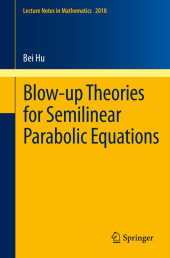 Neuerscheinungen 2011Stand: 2020-01-07 |
Schnellsuche
ISBN/Stichwort/Autor
|
Herderstraße 10
10625 Berlin
Tel.: 030 315 714 16
Fax 030 315 714 14
info@buchspektrum.de |

Bei Hu
Blow-up Theories for Semilinear Parabolic Equations
2011. 2011. x, 127 S. 2 SW-Abb. 235 mm
Verlag/Jahr: SPRINGER, BERLIN 2011
ISBN: 3-642-18459-6 (3642184596)
Neue ISBN: 978-3-642-18459-8 (9783642184598)
Preis und Lieferzeit: Bitte klicken
There is a range of literature dealing with the blow-up behavior of evolution equations, but this book´s fresh approach elucidates the theory by focusing on methodology, eschewing large-scale technical computations in favor of a simple illustrative equation.
There is an enormous amount of work in the literature about the blow-up behavior of evolution equations. It is our intention to introduce the theory by emphasizing the methods while seeking to avoid massive technical computations. To reach this goal, we use the simplest equation to illustrate the methods; these methods very often apply to more general equations.
1 Introduction.- 2 A review of elliptic theories.- 3 A review of parabolic theories.- 4 A review of fixed point theorems.-5 Finite time Blow-up for evolution equations.- 6 Steady-State solutions.- 7 Blow-up rate.- 8 Asymptotically self-similar blow-up solutions.- 9 One space variable case
From the reviews:
"The book approaches the blow-up theories for semilinear parabolic equations using maximum principles and a priori estimates. ... this book is an excellent mathematical monograph and a valuable reference for researchers in the field of nonlinear partial differential equations. This book also clearly benefits instructors who need a solid and updated text for a topic course in partial differential equations. The author has produced a commendable work of scholarly achievement." (Hongwei Chen, Mathematical Reviews, Issue 2012 i)
"These lecture notes are intended for graduate students ... of basic theory of second-order parabolic and elliptic equations. ... At the end of each chapter, there is a set of well-chosen exercises. ... It is a nice addition to the existing literature on blow-up since the previous books were mostly intended for more advanced readers." (Marek Fila, Zentralblatt MATH, Vol. 1226, 2012)


